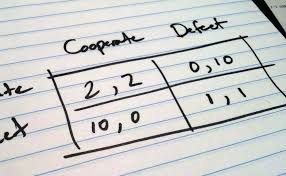Game theory and construction
Game theory is the study of mathematical modelling techniques, used across many fields where some degree of strategy is needed. It can be used in construction as an efficient framework for decision-making and dispute resolution.
While it was originally based around zero-sum games – one person’s gains result in other’s losses – game theory today is more commonly used as a broad term for logical decision-making and can be used as a tool for project management.
Game theory was first developed in the 1950s by scientists such as John Nash and John van Neumann.
The reason for game theory’s applicability across many different disciplines is that it is concerned with decision-making among groups of people where the outcome for each person depends on the actions of everyone in the group. Using applied mathematics, predictions can be made regarding an individual’s decision-making strategy, depending on the choices and thinking of the others.
The ‘Prisoner’s Dilemma’ is a classic example of game theory, revealing why two ‘rational’ individuals may not choose to cooperate despite both being aware that to do so appears to be in their best interest.
Two prisoners are held for a burglary. Each prisoner is offered the following deals:
- They will serve a full prison sentence if both confess.
- If one confesses and agrees to testify against the other, they will go free while the other will serve the full sentence.
- If neither prisoner confesses both will share a lesser sentence.
It is in both prisoners’ best interest to share the lesser sentence and not testify against one another. However, neither prisoner can be sure that the other will stay silent. According to game theory therefore, both prisoners will follow their self-interest and confess.
Game theory has also been used in the study of the construction bidding practices. Bidding is undertaken between competing parties, with conflict bringing into play many of the factors that influence the decision of the final bid.
A contractor may raise or lower their price due to a lack of information. The ‘winner’s curse’, usually associated with auctions, refers to a tendency for contractors to offer a price which reduces the prospects of the project being viable for them in terms of profitability. Winner’s curse can be attributed to :
- Inaccurate estimates of project costs.
- New contractors entering a market.
- Minimising losses in case of recession of the industry or wider economy.
- Strong competition within the construction market.
- Differential opportunity costs.
- Winning the bid and then increasing the price through variation orders, claims, and so on.
An effective project manager, managing progress and deciding on priorities, will negotiate with a range of different stakeholders and arrive at solutions that are advantageous for the project as a whole.
When entering negotiations, they should consider:
- The issue that has to be solved.
- The parties involved in the issue.
- The parties who will have an impact on the success of the decision taken.
- Whether there are any time or cost issues.
- Whether they should make decisions independently or wait for others to make their decisions.
- Whether mutual gain is possible.
- What their end goals are, and so on.
By looking at the best possible outcomes and working backward from them using game theory, project managers may be able to identify and implement the optimum strategy.
[edit] Related articles on Designing Buildings
Featured articles and news
The UK's Modern Industrial Strategy: A 10 year plan
Previous consultation criticism, current key elements and general support with some persisting reservations.
Building Safety Regulator reforms
New roles, new staff and a new fast track service pave the way for a single construction regulator.
Architectural Technologist CPDs and Communications
CIAT CPD… and how you can do it!
Cooling centres and cool spaces
Managing extreme heat in cities by directing the public to places for heat stress relief and water sources.
Winter gardens: A brief history and warm variations
Extending the season with glass in different forms and terms.
Restoring Great Yarmouth's Winter Gardens
Transforming one of the least sustainable constructions imaginable.
Construction Skills Mission Board launch sector drive
Newly formed government and industry collaboration set strategy for recruiting an additional 100,000 construction workers a year.
New Architects Code comes into effect in September 2025
ARB Architects Code of Conduct and Practice available with ongoing consultation regarding guidance.
Welsh Skills Body (Medr) launches ambitious plan
The new skills body brings together funding and regulation of tertiary education and research for the devolved nation.
Paul Gandy FCIOB announced as next CIOB President
Former Tilbury Douglas CEO takes helm.
UK Infrastructure: A 10 Year Strategy. In brief with reactions
With the National Infrastructure and Service Transformation Authority (NISTA).
Ebenezer Howard: inventor of the garden city. Book review.
The Grenfell Tower fire, eight years on
A time to pause and reflect as Dubai tower block fire reported just before anniversary.
Airtightness Topic Guide BSRIA TG 27/2025
Explaining the basics of airtightness, what it is, why it's important, when it's required and how it's carried out.
Construction contract awards hit lowest point of 2025
Plummeting for second consecutive month, intensifying concerns for housing and infrastructure goals.
Understanding Mental Health in the Built Environment 2025
Examining the state of mental health in construction, shedding light on levels of stress, anxiety and depression.






















